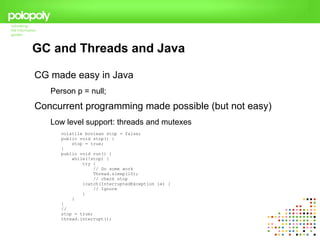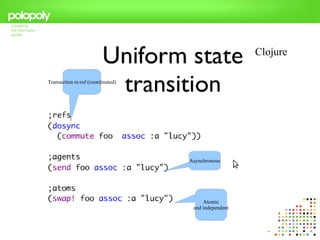Threads and concurrency in Java 1.5
- 2. Notes on Concurrent, parallel programming with threads Concurrent = work done in several computational processes, only requires one CPU Parallel = work (computations) done simultaneous, requires multiple CPU:s – locally or distributed
- 3. GC and Threads and Java CG made easy in Java Person p = null; Concurrent programming made possible (but not easy) Low level support: threads and mutexes volatile boolean stop = false; public void stop() { stop = true; } public void run() { while(!stop) { try { // Do some work Thread.sleep(10); // check stop }catch(InterruptedException ie) { // Ignore } } } // stop = true; thread.interrupt();
- 4. Some Hard stuff Data visibility between threads Volitile semantics Asynchronous code Race conditions and Deadlocks Congestion/Performance
- 5. Data visibility Data not guaranteed to be visable between threads without synchronization long and double not even guaranteed to be ”complete” // In thread 1 at time 1 commonObject.myLong = Long.MAX_VALUE; // In thread 2 at time 2 if(commonObject.myLong > Integer.MAX_VALUE) {
- 6. Broken objects The ordering of access to a reference and a constructed object is not guaranteed
- 7. If one thread can see an object another thread constructs it might see broken objects (ref available before object constructed)
- 8. Double locking // Broken multithreaded version // "Double-Checked Locking" idiom class Foo { private Helper helper = null; public Helper getHelper() { if (helper == null) synchronized(this) { if (helper == null) helper = new Helper(); } return helper; } // other functions and members... }
- 9. Volitile behaviour up until Java 1.4 The Java memory model did not guarantee non reordering on Volatile before 1.5 class VolatileExample { int x = 0; volatile boolean v = false; public void writer() { // Before 1.5 could be done in any order x = 42; v = true; } public void reader() { if (v == true) { //uses x - guaranteed to see 42. } } } // Works with acquire/release semantics for volatile // Broken under current semantics for volatile class Foo { private volatile Helper helper = null; public Helper getHelper() { if (helper == null) { synchronized(this) { if (helper == null) helper = new Helper(); } } return helper; } } Broken up until 1.5 The order of x and v not guaranteed in 1.4
- 10. Sending asynchronous messages is complex public void fetchAsync() { Thread t = new Thread(new Runnable() { public void run() { // Do work in other thread dataArived("hello"); } }); t.start(); } public synchronized void dataArived(String s) { // Update data, must be synchronized somehow to be visable }
- 11. Reading and writing common data always requires synchronization Sets a limit to scalability
- 12. Amdahl's law (simlified): 1/(1 – p)
- 13. where P is percentage parallelizable work gives the maximum number of CPU:s that are meaningfull to use when speed is considered.
- 14. For example, of 5 percent of the application is serialized because of a common synchronization (such as read on a cache), the maximum number of CPU:s are 20
- 15. To fully gain througout by 64 cores about 99 % must be parallelizable
- 16. Polopoly on multi core machines
- 17. Better data structures from JDK 1.5 – using modern memory management techniques ConcurrentHashMap
- 18. Lock striping
- 19. Optimized for reads: does not block reads even when its updated
- 20. Does often not block on updates either
- 22. Atomic check and take action methods V putIfAbsent(K key, V value); boolean remove(Object key, Object value); V replace(K key, V value); boolean replace(K key, V oldValue, V newValue);
- 23. ExecutorService Extension to Executor
- 25. May track submitted task and get result back
- 26. Uses Future and Callable Callable<String> worker = new Callable<String>() { int c = 0; public String call() { try {Thread.sleep(2000L);}catch(Exception ignore){} return "jobb no " + c++; } }; ExecutorService exe = Executors.newSingleThreadExecutor(); Future<String> result = exe.submit(worker); while(!result.isDone()) { // Do something other } String s = result.get();
- 28. volatile but with conditional atomicity
- 29. Finer granularity of locking (hardware based)
- 30. Non blocking
- 31. Built on optimistic assumptions: do it, check and redo
- 32. Non blocking counting AtomicLong at = new AtomicLong(); // one thread, no synchronzied long current = at.get(); // another thread increment, no sync at.incrementAndGet();
- 33. To really solve the parallelity problem you have to look at the world differently Value (immutable)
- 34. Identity (holder of values over time)
- 35. State (value of an identity at a point of time)
- 36. Time (ordering)
- 37. PDS
- 38. Clojure Clojure Transaction re-ref (coordinated) Asynchronous Atomic and independent
- 39. Some buzwords to remember Transactional Memory
- 42. Imutable

















